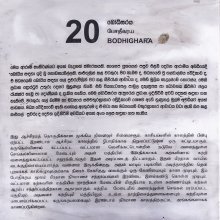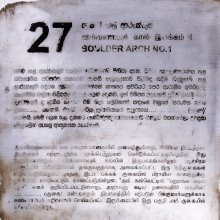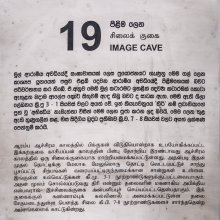Attan, Aṭṭaṉ, Attaṉ, Attāṉ, Āttaṉ, Āttāṉ: 2 definitions
Introduction:
Attan means something in Buddhism, Pali, Tamil. If you want to know the exact meaning, history, etymology or English translation of this term then check out the descriptions on this page. Add your comment or reference to a book if you want to contribute to this summary article.
Images (photo gallery)
Languages of India and abroad
Pali-English dictionary
Source: Sutta: The Pali Text Society's Pali-English DictionaryAttan, (m.) & atta (the latter is the form used in compn. ) (Vedic ātman, not to Gr. a)νemos = Lat. animus, but to Gr. a)tmόs steam, Ohg. ātum breath, Ags. aepm).—I. Inflection. (1) of attan- (n. stem); the foll. cases are the most frequent : Acc. attānaṃ D. I, 13, 185; S. I, 24; Sn. 132, 451.—Gen. Dat. attano Sn. 334, 592 etc., also as Abl. A. III, 337 (attano ca parato ca as regards himself and others).—Instr. Abl. attanā S. I, 24; Sn. 132, 451; DhA. II, 75; PvA. 15, 214 etc. On use of attanā see below III, 1 C.—Loc. attani S. V, 177; A. I, 149 (attanī metri causa); II, 52 (anattani); III, 181; M. I, 138; Sn. 666, 756, 784; Vbh. 376 (an°).—(2) of atta- (a-stem) we find the foll. cases: Acc. attaṃ Dh. 379.—Instr. attena S. IV, 54.—Abl. attato S. I, 188; Ps. I, 143; II, 48; Vbh. 336.
Meanings. 1. The soul as postulated in the animistic theories held in N India in the 6th and 7th cent. B. C. It is described in the Upanishads as a small creature, in shape like a man, dwelling in ordinary times in the heart. It escapes from the body in sleep or trance; when it returns to the body life and motion reappear. It escapes from the body at death, then continues to carry on an everlasting life of its own. For numerous other details see Rh. D. Theory of Soul in the Upanishads J R A S 1899. Bt. India 251—255. Buddhism repudiated all such theories, thus differing from other religions. Sixteen such theories about the soul D. I, 31. Seven other theories D. I, 34. Three others D. I, 186/7. A “soul” according to general belief was some thing permanent, unchangeable, not affected by sorrow S. IV, 54 = Kvu 67; Vin. I, 14; M. I, 138. See also M. I, 233; III, 265, 271; S. II, 17, 109; III, 135; A. I, 284; II, 164, 171; V, 188; S. IV, 400. Cp. ātuman, tuma, puggala, jīva, satta, pāṇa and nāma-rūpa.
2. Oneself, himself, yourself. Nom. attā, very rare. S. I, 71, 169; III, 120; A. I, 57, 149 (you yourself know whether that is true or false. Cp. Manu VIII, 84. Here attā comes very near to the European idea of conscience. But conscience as a unity or entity is not accepted by Buddhism) Sn. 284; Dh. 166, 380; Miln. 54 (the image, outward appearance, of oneself). Acc. attānaṃ S. I, 44 (would not give for himself, as a slave) A. I, 89; Sn. 709. Acc. attaṃ Dh. 379. Abl. attato as oneself S. I, 188; Ps. I, 143; II, 48; Vbh. 336. Loc. attani A. I, 149; III, 181; Sn. 666, 784. Instr. attanā S. I, 57 = Dh. 66; S. I, 75; II, 68; A. I, 53; III, 211; IV, 405; Dh. 165. On one’s own account, spontaneously S. IV, 307; V, 354; A. I, 297; II, 99, 218; III, 81; J. I, 156; PvA. 15, 20. In composition with numerals attadutiya himself and one other D. II, 147; °catuttha with himself as fourth M. I, 393; A. III, 36; °pañcama Dpvs VIII, 2; °sattama J. I, 233; °aṭṭhama VvA. 149 (as atta-naṭṭhama Vv 3413), & °aṭṭhamaka Miln. 291.
anattā (n. and predicative adj.) not a soul, without a soul. Most frequent in combn. with dukkha & anicca — (1) as noun: S. III, 141 (°anupassin); IV, 49; V, 345 (°saññin); A. II, 52 = Ps. II, 80 (anattani anattā; opp. to anattani attā, the opinion of the micchādiṭṭhigatā sattā); Dh. 279; Ps. II, 37, 45 sq. (°anupassanā), 106 (yaṃ aniccañ ca dukkhañ ca taṃ anattā); DhA. III, 406 (°lakkhaṇa).—(2) as adj. (pred.): S. IV, 152 sq. ; S. IV, 166; S. IV, 130 sq. , 148 sq. ; Vin. I, 13 = S. III, 66 = Nd2 680 Q 1; S. III, 20 sq. ; 178 sq. , 196 sq. ; sabbe dhammā anattā Vin. V, 86; S. III, 133; IV, 28, 401.

Pali is the language of the Tipiṭaka, which is the sacred canon of Theravāda Buddhism and contains much of the Buddha’s speech. Closeley related to Sanskrit, both languages are used interchangeably between religions.
Tamil dictionary
Source: DDSA: University of Madras: Tamil LexiconAṭṭaṉ (அட்டன்) noun < aṣṭan. Śiva, as having aṭṭa-mūrttam, q.v.; அட்டமூர்த்தியான சிவபிரான். [attamurthiyana sivapiran.] (தேவாரம் [thevaram] 855, 8.)
--- OR ---
Attaṉ (அத்தன்) noun cf. Pkt. attā.
1. Father; தகப்பன். என்னத்தனை வென்றிசை கொண்டிலனோ [thagappan. ennathanai venrisai kondilano] (கந்தபு. காமதக. [kanthapu. kamathaga.] 10).
2. Elder; மூத்தோன். (திவா.) [muthon. (thiva.)]
3. Priest; குரு. [kuru.] (மகாபாரதம் பதினைந். [magaparatham pathinain.] 27.)
4. Person of rank or eminence; உயர்ந்தோன். [uyarnthon.] (திருவிளையாடற் புராணம் மெய்க்காட். [thiruvilaiyadar puranam meykkad.] 34.)
5. Śiva, Viṣṇu, Arhat; சிவன், விஷ்ணு, அருகன். (சூடாமணிநிகண்டு) [sivan, vishnu, arugan. (sudamaninigandu)]
--- OR ---
Attaṉ (அத்தன்) noun probably from அத்து-. [athu-.]
1. Chebulic myrobalan. See கடுக்காய். (வைத்திய மூலிகை). [kadukkay. (vaithiya muligai).]
2. White lead; வெள்ளீயம். (வைத்திய மூலிகை) [velliyam. (vaithiya muligai)]
--- OR ---
Attāṉ (அத்தான்) noun
1. probably from அத்தை. [athai.] Father's sister’s son; அத்தை மகன். [athai magan.]
2. Maternal uncle’s son when elder; அம்மான் மகன். [amman magan.] Local usage
3. Wife's brother, when elder; மனைவி தமையன். [manaivi thamaiyan.] Local usage
--- OR ---
Attāṉ (அத்தான்) noun cf. atti. Elder sister’s husband; அக்காள் புருஷன். [akkal purushan.]
--- OR ---
Āttaṉ (ஆத்தன்) noun < āpta.
1. Friend, இஷ்டன். [ishdan.] (நாலாயிர திவ்யப்பிரபந்தம் திருவாய்மொழி [nalayira thivyappirapandam thiruvaymozhi] 10, 1, 6.)
2. Trustworthy person, one whose words are reliable and authoritative; நம்பத்தக்கோன். ஆத்தனுடைய வசனம். [nambathakkon. athanudaiya vasanam.]
3. Arhat; அருகன். (சூடாமணிநிகண்டு) [arugan. (sudamaninigandu)]
--- OR ---
Āttāṉ (ஆத்தான்) noun < āpta. Superior person; பெரிய.ோன். (சம்பிரதாயவகராதி) [periyon. (sambirathayavagarathi)]
--- OR ---
Attāṉ (அத்தான்) noun < முடக்கற்றான். [mudakkarran.] Balloon vine; மூடக்கொற்றான். (பரிபாசை அகராதி) [mudakkorran. (paripasai agarathi)]
Tamil is an ancient language of India from the Dravidian family spoken by roughly 250 million people mainly in southern India and Sri Lanka.
See also (Relevant definitions)
Starts with (+63): Atta-nakapantam, Attabhava, Attadanda, Attadanta, Attadhina, Attadhipaka, Attadhipateyya, Attadipa, Attaditthi, Attagarahin, Attaghanna, Attagutta, Attagutti, Attahetu, Attahita, Attaja, Attakama, Attakara, Attakata, Attakilamatha.
Ends with (+133): Acalakattan, Akkattan, Ampalanattan, Anaiccattan, Anaivekkattan, Ankattan, Antuvan-cattan, Appakkutattan, Arakkuccokkattan, Aranattan, Arattan, Ataikkalankattan, Avattan, Avviyattan, Ayalattan, Caka-calapurattan, Caka-talapurattan, Cakappurattan, Cakattan, Camattan.
Full-text (+93): Attanmatani, Sapatha, Ayalattan, Samanatta, Ravatha, Atanmai, Attadanda, Vikalanam, Attasarana, Attagutta, Rudatha, Attaghanna, Attadhina, Attagarahin, Attapaccakkhika, Attasambhuta, Attadanta, Kuttumatippay, Attaja, Attadhipateyya.
Relevant text
Search found 8 books and stories containing Attan, Aathaan, Aathan, Athaan, Athan, Aṭṭaṉ, Attaṉ, Attāṉ, Āttaṉ, Āttāṉ; (plurals include: Attans, Aathaans, Aathans, Athaans, Athans, Aṭṭaṉs, Attaṉs, Attāṉs, Āttaṉs, Āttāṉs). You can also click to the full overview containing English textual excerpts. Below are direct links for the most relevant articles:
Tiruvaymoli (Thiruvaimozhi): English translation (by S. Satyamurthi Ayyangar)
Pasuram 3.7.3 < [Section 7 - Seventh Tiruvaymoli (Payilum Cutar oti)]
Pasuram 10.1.6 < [Section 1 - First Tiruvaymoli (Tala tamarai)]
Annadatri-carita (study) (by Sarannya V.)
3. Representation of Uthiyan Cheralathan in History < [Chapter 2 - Depiction of King Utiyan Ceralatan in History and Literature]
Dhammapada (Illustrated) (by Ven. Weagoda Sarada Maha Thero)
Verse 165 - The Story of Cūlakāla Upāsaka < [Chapter 12 - Atta Vagga (Self)]
Verse 161 - The Story of Mahākāla Upāsaka < [Chapter 12 - Atta Vagga (Self)]
Verse 160 - The Story of the Mother of Kumārakassapa < [Chapter 12 - Atta Vagga (Self)]
The Religion and Philosophy of Tevaram (Thevaram) (by M. A. Dorai Rangaswamy)
Chapter 60 - Thirukachi Anegathangavatham or Tirukkacci Anekatankavatam (Hymn 10) < [Volume 3.5 - Pilgrim’s progress: to the North]
Chapter 70 - Thiruvalangadu or Tiruvalankatu (Hymn 52) < [Volume 3.6 - Pilgrim’s progress: away from Otriyur and Cankili]
Chapter 4.3 - (e) Arurar’s references to Dance < [Volume 2 - Nampi Arurar and Mythology]
Later Chola Temples (by S. R. Balasubrahmanyam)
Temples in Tiruvalangadu < [Chapter II - Temples of Kulottunga I’s Time]
Sivaprakasam (Study in Bondage and Liberation) (by N. Veerappan)
Three forms of deeds < [Chapter 2 - Bondage]





